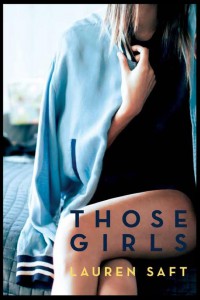 Although occasionally bawdy with its vulgar language, illicit activities, and other questionable behaviors, Those Girls examines the lives of three girls attempting to deal with their insecurities, fears, and vulnerabilities about being pretty or talented or special. In this debut novel by Lauren Saft, Mollie Finn, Alex Holbrook, and Veronica Collins have been BFFs since fifth grade, and their friendship has served as a life raft in the turbulent waters of private school at Harwin, an all-girls academy in Greencliff, Pennsylvania. But junior year—with its boy troubles and other social challenges—stretches the bonds of their friendship to the breaking point, and it might take more than a single summer to perform a “master cleanse and reset” to overcome the anger, sadness, and disappointment inflicted by their actions.
Although occasionally bawdy with its vulgar language, illicit activities, and other questionable behaviors, Those Girls examines the lives of three girls attempting to deal with their insecurities, fears, and vulnerabilities about being pretty or talented or special. In this debut novel by Lauren Saft, Mollie Finn, Alex Holbrook, and Veronica Collins have been BFFs since fifth grade, and their friendship has served as a life raft in the turbulent waters of private school at Harwin, an all-girls academy in Greencliff, Pennsylvania. But junior year—with its boy troubles and other social challenges—stretches the bonds of their friendship to the breaking point, and it might take more than a single summer to perform a “master cleanse and reset” to overcome the anger, sadness, and disappointment inflicted by their actions.
Mollie, who is regimented and self-conscious, doesn’t like change; Veronica, who has a “smokin’ hot” figure and uses it, missed the embarrassment gene; and Alex, who likes car dancing to the radio and “long insightful talks about art and life” (30), has an irreverent sense of style. While the book is organized by chapters from each girl’s perspective, the novel’s true protagonist is Alex—“the chill one, the least cute one who smokes weed and talks music and holds her liquor” (56).
Drew Carson, Josh Holbrook, Sam Fuchs, and a pack of other males perpetuate the plot as Saft tells the tale of teens who take risks in the name of wanting to fit in, to experience the feeling of belonging, to be desired and desirable. Retelling a year of toxicity—of secrets, lies, and self-absorption—Saft’s novel reads a little like a soap-opera plot. With its conflicts, which recount the desperate things people do to keep relationships together or interesting, the teens take tips from Cosmo to create an illusion, pretending to be someone else, as they look for love and acceptance.
While this book reveals what occasionally feels like stereotypical adolescent angst, it also remains true to teen psychology—the need for attention—to be cool, accepted, noticed, or liked drives behavior and choices. Even as adults, we possess a need to impress, worrying what others think and working to avoid pathetic status.
Besides focusing on feelings of being unsure, unworthy, selfish, and self-conscious, the novel explores a thread about art’s power and its connection to love and survival. For both Alex and Drew, art provides an outlet for emotional expression and intellectual exploration. Alex finds her release in music; Drew escapes in writing. Music makes Alex feel safe, secure, and protected. When life spirals out of control, music centers her, brings her back to herself again. A form of catharsis, music provides a channel for her strong emotions, allowing her to “[change] the sound in [her] head. . . drown out the noise, turn off the words, black out the pictures” (121).
The novel’s crowning moment comes when Drew and Alex have a conversation via art. In a moment of creation and musical transcendence, Alex writes a song inspired by Drew’s writing, a song she later performs at prom. “Grow Up” is “about how being an adult means knowing who you are, and how being a friend means seeing someone for who they really are, not just who you need them to be” (251).
Swirling in sex and drama and irresponsibility, the teens learn that anger, frustration, jealousy, and fear cause major misdirection. With their mistakes, they teach all readers that once we’ve fallen too deeply into the hole of deceit and denial, we have to own up to our mistakes and atone for our moral meltdowns.
- Posted by Donna

